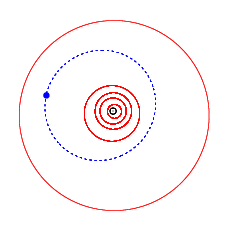1000 Piazzia on:
[Wikipedia]
[Google]
[Amazon]
1000 Piazzia, provisional designation ', is a carbonaceous background
 ''Piazzia'' is a non-
''Piazzia'' is a non-
asteroid
An asteroid is a minor planet of the inner Solar System. Sizes and shapes of asteroids vary significantly, ranging from 1-meter rocks to a dwarf planet almost 1000 km in diameter; they are rocky, metallic or icy bodies with no atmosphere.
...
from the outer region of the asteroid belt
The asteroid belt is a torus-shaped region in the Solar System, located roughly between the orbits of the planets Jupiter and Mars. It contains a great many solid, irregularly shaped bodies, of many sizes, but much smaller than planets, called ...
, approximately in diameter. It was discovered on 12 August 1923, by German astronomer Karl Reinmuth
Karl Wilhelm Reinmuth (4 April 1892 in Heidelberg – 6 May 1979 in Heidelberg) was a German astronomer and a prolific discoverer of 395 minor planets.
Scientific career
From 1912 to 1957, Reinmuth was working as an astronomer at the Lande ...
at Heidelberg Observatory
Heidelberg (; Palatine German: ') is a city in the German state of Baden-Württemberg, situated on the river Neckar in south-west Germany. As of the 2016 census, its population was 159,914, of which roughly a quarter consisted of students.
...
in southern Germany. The C-type asteroid
C-type (carbonaceous) asteroids are the most common variety, forming around 75% of known asteroids. They are volatile-rich and distinguished by a very low albedo because their composition includes a large amount of carbon, in addition to rocks ...
has a rotation period
The rotation period of a celestial object (e.g., star, gas giant, planet, moon, asteroid) may refer to its sidereal rotation period, i.e. the time that the object takes to complete a single revolution around its axis of rotation relative to the ...
of 9.5 hours. It was named after Italian Giuseppe Piazzi
Giuseppe Piazzi ( , ; 16 July 1746 – 22 July 1826) was an Italian Catholic priest of the Theatine order, mathematician, and astronomer. He established an observatory at Palermo, now the '' Osservatorio Astronomico di Palermo – Giuseppe ...
, who discovered 1 Ceres
Ceres (; minor-planet designation: 1 Ceres) is a dwarf planet in the asteroid belt between the orbits of Mars and Jupiter. It was the first asteroid discovered, on 1 January 1801, by Giuseppe Piazzi at Palermo Astronomical Observatory in Sici ...
.
Orbit and classification
 ''Piazzia'' is a non-
''Piazzia'' is a non-family
Family (from la, familia) is a Social group, group of people related either by consanguinity (by recognized birth) or Affinity (law), affinity (by marriage or other relationship). The purpose of the family is to maintain the well-being of its ...
asteroid from the main belt's background population. It orbits the Sun in the outer
{{Short pages monitor
Asteroid Lightcurve Database (LCDB)
query form
)
Dictionary of Minor Planet Names
Google books
– Observatoire de Genève, Raoul Behrend
– Minor Planet Center * * {{DEFAULTSORT:Piazzia 001000 Discoveries by Karl Wilhelm Reinmuth Named minor planets 19230812
External links
Asteroid Lightcurve Database (LCDB)
query form
)
Dictionary of Minor Planet Names
Google books
– Observatoire de Genève, Raoul Behrend
– Minor Planet Center * * {{DEFAULTSORT:Piazzia 001000 Discoveries by Karl Wilhelm Reinmuth Named minor planets 19230812